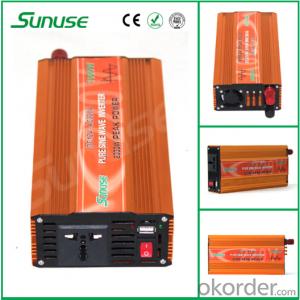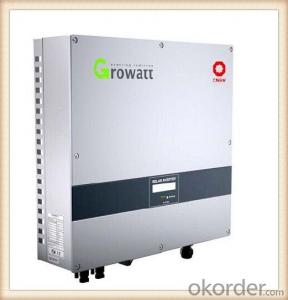Solar Inverter 230v CNBM-H 2KW Hybrid Inverter
- Loading Port:
- Shanghai
- Payment Terms:
- TT OR LC
- Min Order Qty:
- 1000 watt
- Supply Capability:
- 100000000 watt/month
OKorder Service Pledge
OKorder Financial Service
You Might Also Like
1.Description of the Solar Inverter
2KW hybrid inverter
Pure sine wave output
Microprocessor controlled to guarantee stable charging system
Multiple operations: Grid tie , Off grid , and grid tie with backup
Built-in MPPT solar charger
LCD display panel for comprehensive information
Multiple communication
Green substitution for generators
User adhustable charging current up to 25A
2.Data sheet of the Solar Inverter
| Model | CNBM-H 2KW |
| Rated Power | 2000W |
| Grid-tie operation | |
| PV Input(DC) | |
| Maximum DC power | 2250W |
| Nominal DC voltage / Maximum DC voltage | 300 VDC/350 VDC |
| Start voltage /Initial Feeding Voltage | 80 VDC/120 VDC |
| MPP voltage range | 150 VDC ~ 320 VDC |
| Number of MPP Trackers/ Max input current | 1/1 X15A |
| GRID OUTPUT (AC) | |
| Nominal Output Voltage | 101/110/120/127 VAC |
| Output Voltage Range | 88 - 127 VAC |
| Nominal Output Current | 30A |
| Power Factor | >0.99 |
| EFFICIENCY | |
| Maximum Conversion Efficiency (DC/AC) | 95% |
| European Efficiency@ Vnominal | 94% |
| OFF-GRID OPERATION | |
| AC INPUT | |
| AC Startup Voltage /Auto Restart Voltage | 60 - 70 VAC / 85 VAC |
| Acceptable Input Voltage Range | 85 - 130 VAC |
| Maximum AC Input Current | 30A |
| PV INPUT (DC) | |
| Maximum DC Voltage | 350 VAC |
| MPP Voltage Range | 150 VAC~320 VAC |
| Maximum Input Current | 1/1 X15A |
| BATTERY MODE OUTPUT (AC) | |
| Nominal Output Voltage | 101/110/120/127 VAC |
| Output Frequency | 50HZ/60HZ(auto sensing) |
| Output Waveform | Pure sine wave |
| Efficiency (DC to AC) | 90% |
| HYBRID OPERATION | |
| PV INPUT (DC) | |
| Nominal DC voltage / Maximum DC voltage | 300 VDC/ 350 VDC |
| Start voltage /Initial Feeding Voltage | 80 VDC /120VDC |
| MPP voltage range | 150VDC ~320VDC |
| Maximum Input Current | 1/1 X15A |
| GRID OUTPUT (AC) | |
| Nominal Output Voltage | 101/110/120/127 VAC |
| Output Voltage Range | 88 ~127 VAC |
| Nominal Output Current | 18A |
| AC INPUT | |
| AC Startup Voltage /Auto Restart Voltage | 60 - 70 VAC /85 VAC |
| Acceptable Input Voltage Range | 85 - 130 VAC |
| Maximum AC Input Current | 30A |
| BATTERY MODE OUTPUT (AC) | |
| Nominal Output Voltage | 101/110/120/127 VAC |
| Efficiency (DC to AC) | 90% |
| BATTERY & CHARGER | |
| Nominal DC Voltage | 48VDC |
| Maximum Charging Current | 25A |
| GENERAL | |
| PHYSICAL | |
Dimension, D X W X H (mm) | 420x415x170 |
| Net Weight (kgs) | 15.5 |
| INTRRF ACE | |
| Communication Port | RS-232/USB |
| Intelligent Slot | Optional SNMP ,Modbus, and AS400 cards available |
| COMPLIANCE | |
| Standard | CE, VDE, 0216-1-1, VDE-AR-N 4105 |
3.Applications of the Solar Inverter
Inverter not only has direct communication transform function, but also has the maximum limit to carry on the function of the solar cell function and system fault maintenance function. In the aggregate, have active operation and shutdown function, maximum power tracking control function, prevent operation function alone (grid system use), the active voltage adjustment functions (grid system use), dc testing functions (grid system use), dc grounding detection function (grid system use)
4.IMages of the Solar Inverter



FAQ
Q: Do you have the CE, TUV, UL Certification?
A: We’ve already passed all the tests, and any certificate is available.
Q: Have you ever sold your products to companies in my country?
A: Of course, we have customers in all general PV markets, but I think we should expand our market share along with the market growth.
Q: When did your company set up? You are a new company, how can I believe your quality?
A: We entered into Solar PV industry in 2005, now we have several plants in manufacturing of a-Si and c-Si panels, and our capacity is 220MW per year. Till now we have already passed all the tests by authorized laboratories, e.g. TUV, CE, UL.
Q: Can you help us install the module if we cooperate with you?
A: We haven’t entered into installation sector, but we have the plan in near future.
Q: How do you pack your products?
A: We have rich experience on how to pack the panels to make sure the safety on shipment when it arrives at the destination.
Q: Can you do OEM for us?
A: Yes, we can.
Q: Can we visit your factory?
A: Surely, I will arrange the trip basing on your business schedule.
- Q: Can a solar inverter be used in conjunction with a smart home system?
- Yes, a solar inverter can be used in conjunction with a smart home system. The smart home system can integrate with the solar inverter to monitor and control the energy production, consumption, and storage. This allows for better optimization of energy usage, remote monitoring, and automated control of various devices and appliances within the smart home.
- Q: What is the role of a power quality analyzer in a solar inverter?
- The role of a power quality analyzer in a solar inverter is to monitor and analyze the quality of the electrical power being generated by the solar panels. It measures various parameters such as voltage, current, frequency, harmonics, and power factor to ensure that the power being generated is within acceptable limits and meets the required standards. By detecting any deviations or abnormalities in the power quality, the analyzer helps in identifying and rectifying issues that could affect the performance and efficiency of the solar inverter and the overall solar power system.
- Q: Can a solar inverter be used without solar panels?
- No, a solar inverter cannot be used without solar panels. The purpose of a solar inverter is to convert the direct current (DC) generated by solar panels into alternating current (AC) that can be used to power electrical devices in a home or building. Without solar panels producing DC electricity, there would be no input for the inverter to convert.
- Q: What is the role of a power monitoring feature in a solar inverter?
- The role of a power monitoring feature in a solar inverter is to track and measure the amount of power generated by the solar panels. It provides real-time data on the energy production, allowing users to monitor the system's performance, identify any issues or inefficiencies, and optimize the overall energy output. This feature is crucial for ensuring the effective and efficient operation of a solar power system.
- Q: What is the maximum number of solar panels that a solar inverter can support?
- The maximum number of solar panels that a solar inverter can support depends on the specific model and capacity of the inverter. Different inverters have different power ratings and input capacities, which determine the number of solar panels they can handle. It is important to consult the manufacturer's specifications or consult with a professional to determine the appropriate number of panels that can be supported by a particular solar inverter.
- Q: How does a solar inverter handle grid islanding conditions?
- A solar inverter handles grid islanding conditions by continuously monitoring the grid voltage and frequency. In the event of a grid outage or disturbance, the solar inverter detects the change and disconnects from the grid to ensure the safety of utility workers. It then enters islanding mode, wherein it generates electricity from the solar panels and supplies it to the local loads. This prevents backfeeding and maintains a stable power supply within the isolated system.
- Q: Can a solar inverter be used with a net metering system?
- Yes, a solar inverter can be used with a net metering system. In fact, a solar inverter is an essential component of a net metering system. It converts the direct current (DC) electricity generated by the solar panels into alternating current (AC) electricity that can be used to power the home or business. The excess electricity produced by the solar panels is fed back into the grid through the net meter, allowing the utility company to credit the owner for the excess energy produced.
- Q: Can a solar inverter be used in systems with different module types?
- Yes, a solar inverter can be used in systems with different module types. Solar inverters are designed to convert the direct current (DC) generated by solar panels into alternating current (AC) that can be used to power electrical devices. They are compatible with various module types, such as monocrystalline, polycrystalline, and thin-film solar panels, allowing them to be used in diverse solar energy systems.
- Q: How does a solar inverter handle voltage flicker?
- A solar inverter handles voltage flicker by constantly monitoring the grid voltage and adjusting its output to maintain a stable voltage. It uses advanced control algorithms to quickly respond to fluctuations and minimize the impact of voltage flicker on the connected devices.
- Q: What is the role of a solar inverter in a solar-powered electric fence?
- The role of a solar inverter in a solar-powered electric fence is to convert the direct current (DC) generated by the solar panels into alternating current (AC) that is used to power the electric fence system. The inverter ensures that the energy captured by the solar panels is transformed into a usable form for the electric fence, allowing it to function efficiently.
Send your message to us
Solar Inverter 230v CNBM-H 2KW Hybrid Inverter
- Loading Port:
- Shanghai
- Payment Terms:
- TT OR LC
- Min Order Qty:
- 1000 watt
- Supply Capability:
- 100000000 watt/month
OKorder Service Pledge
OKorder Financial Service
Similar products
Hot products
Hot Searches
Related keywords


































